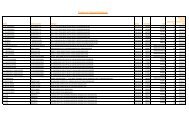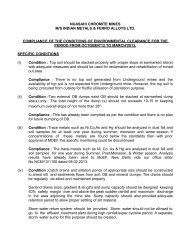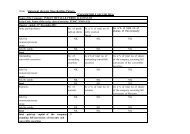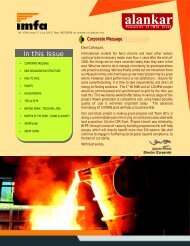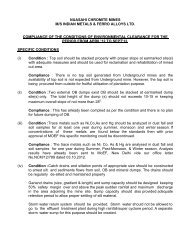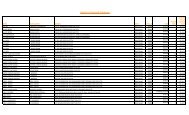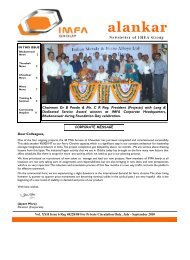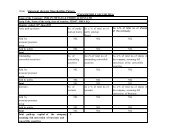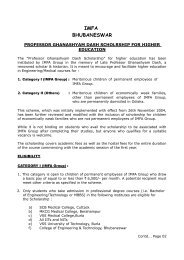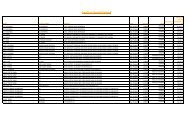The Environement Clearance letter No. J-11015 /346/207-IA ... - IMFA
The Environement Clearance letter No. J-11015 /346/207-IA ... - IMFA
The Environement Clearance letter No. J-11015 /346/207-IA ... - IMFA
Create successful ePaper yourself
Turn your PDF publications into a flip-book with our unique Google optimized e-Paper software.
Conditions of MoEF, Govt. of India, New Delhi vide MoEF Letter <strong>No</strong> - J-<strong>11015</strong>/<strong>346</strong>/2007-<strong>IA</strong>.II(M) Dated 22.05.2012 issued with<br />
Environmental <strong>Clearance</strong> with reference to Sukinda Mines (Chromite) of M/s <strong>IMFA</strong> and the Status of compliance for same for<br />
the period from April'2012 to September'2012.<br />
<strong>The</strong> earlier <strong>Environement</strong> <strong>Clearance</strong> <strong>letter</strong> <strong>No</strong>. J-<strong>11015</strong> /<strong>346</strong>/2007-<strong>IA</strong>.II(M) dated 18 th June 2008 was valid up to 31 st March 2012, as per the<br />
specific condition no 1, given below:<br />
Specific Condition no.1: <strong>The</strong> Environmental <strong>Clearance</strong> shall be upto March 2012 based on existing approved Mine Plan/Scheme as modified<br />
from time to time. For environmental clearance to be valid beyond March 2012, the proponent shall submit a copy of the Mine Plan, duly<br />
approved by the Indian Bureau of Mines incorporating the ultimate pits slope angle, height of the proposed dump and clearly showing<br />
availability of adequate space to accommodate the waste to be generated for the entire mine life latest by December, 2011. If no such<br />
approved mine plan / scheme is submitted to the Ministry of Environment & Forests, the environment clearance shall seize to be valid beyond<br />
March 2012.<br />
Compliance Status: An Approved Scheme of Mining with Progressive Mine Closure Plan valid from 2009-10 to 2013-14 submitted to MoEF on 5th<br />
March 2011.Based on this, the presentation to EAC (MoEF) was made in October 2011, subsequently the Environment <strong>Clearance</strong> for production<br />
of 351,000t of Chromite ore from Sukinda Mines (Chromite) of M/s <strong>IMFA</strong> was extended up to 31 st March 2014 as per <strong>letter</strong> no. J-<strong>11015</strong> /<br />
<strong>346</strong>/<strong>207</strong>-<strong>IA</strong>.II(M) dated 22.05.2012 and the conditions and the compliance status is presented below.<br />
<strong>The</strong> <strong>Environement</strong> <strong>Clearance</strong> <strong>letter</strong> <strong>No</strong>. J-<strong>11015</strong> /<strong>346</strong>/<strong>207</strong>-<strong>IA</strong>.II(M) dated 22.05.2012 states that the specific condition no.1 of the previous<br />
<strong>Environement</strong> <strong>Clearance</strong> NO J-<strong>11015</strong>/<strong>346</strong>/2007-<strong>IA</strong>.II(M) dated 18th June, 2008 is revised as follows:<br />
Sl <strong>No</strong> Specific Condition no.1 – revised vide <strong>letter</strong> <strong>No</strong>. J-<strong>11015</strong> /<br />
<strong>346</strong>/<strong>207</strong>-<strong>IA</strong>.II(M) dated 22.05.2012<br />
Status<br />
(i)<br />
<strong>The</strong> environmental clearance shall be up to March, 2014 based on<br />
existing approved mine plan/scheme as modified from time to time. For<br />
environmental clearance beyond march 2014 will be considered after<br />
the proposal for management of over burden/waste is firmed up and is<br />
reflected in the approved mine plan / mine scheme. If no such approved<br />
mine plan /scheme is submitted to the ministry of Environment and<br />
forests, well in time, the environmental clearance shall seize to be valid<br />
beyond March 2014<br />
It Shall be followed.<br />
Page 01 of 13
An additional condition is also stipulated in the <strong>Environement</strong> <strong>Clearance</strong> vide <strong>letter</strong> <strong>No</strong>. J-<strong>11015</strong> /<strong>346</strong>/<strong>207</strong>-<strong>IA</strong>.II(M) dated 22.05.12. <strong>The</strong><br />
condition and its compliance is presented below.<br />
Sl <strong>No</strong> Additional Condition Status<br />
II<br />
<strong>The</strong> company shall submit within 3 months their policy towards<br />
Corporate Environment Responsibility which should inter-alia provide for<br />
(i) Standard operating process / process to bring into focus any<br />
infringement/ deviation /violation of the Environmental or forest<br />
norms / conditions, (ii) Hierarchical system or Administrative order of<br />
the company to deal with the environmental issues and for ensuring<br />
compliance with the EC conditions and (iii) System of reporting of non<br />
compliances/ violations of environmental norms to the board of<br />
Directors of the company and / or shareholders or stakeholders.<br />
<strong>The</strong> policy towards Corporate Environment Responsibility has been<br />
framed and submitted to Ministry of Environment and Forest on dated<br />
18.08.12. <strong>The</strong> copy of the same is annexed for reference.<br />
<strong>The</strong> Corpoarate Environmental Responsibility Policy specifically provides<br />
for the following:<br />
Standard operating process / procedures to bring into focus any<br />
infringement, deviation or violation of environment or forest norms /<br />
conditions.<br />
Awareness of environmental and forest legislation throughout the<br />
company so that all regulatory requirements are met including<br />
conditions / stipulations / norms specified in environment and forest<br />
clearance.<br />
Monitoring the implementation of the policy by carrying out periodic<br />
compliance audits which are reported to the Board of Directors and,<br />
when appropriate, adopting remedial measures.<br />
Ensuring that during the course of their duties all employees act in<br />
accordance with the policy so as to appropriately deal with any<br />
environmental issues besides complying with all environment clearance<br />
conditions and also encouraging suppliers, contractors and vendors to do<br />
the same.<br />
Giving preference to non-polluting technology, minimising waste<br />
through re-use / recycling and reducing energy consumption.<br />
Maintaining transparency in all matters relating to complience of<br />
environmental conditions / stipulations / norms.<br />
Contributing towards awareness of the local community about the<br />
importance of the environment through open communication and<br />
appropriate CSR activities.<br />
Page 02 of 13
Other conditions of the earlier <strong>Environement</strong> <strong>Clearance</strong> Letter <strong>No</strong>.J-<strong>11015</strong>/<strong>346</strong>/2007-<strong>IA</strong>.II(M) dated 18.06.2008 remains unchanged and their<br />
compliance status is appended below.<br />
Sl <strong>No</strong><br />
Specific Conditions – EC Letter <strong>No</strong>. J-<strong>11015</strong>/<strong>346</strong>/2007-<strong>IA</strong>.II(M)<br />
dated 18 th June, 2008<br />
Status<br />
(iii)<br />
<strong>The</strong> project proponent shall obtain consent to establish from the state<br />
Pollution Control Board, Orissa and effectively implement all the<br />
conditions stipulated therein.<br />
Consent to establish for production of 3.51 Lakh MT of Chrome ore per<br />
annum has been obtained from State Pollution Control Board,Odisha<br />
vide Order <strong>No</strong>.3155/Ind-II-NOC-4869, dated 04/03/2010. All the<br />
conditions stipulated in consent to establish have been implemented<br />
effectively.<br />
(iv)<br />
<strong>The</strong> project proponent shall ensure that no natural watercourse / water<br />
body shall be obstructed due to any mining operation.<br />
<strong>The</strong>re is no natural watercourse/water body exist in the lease hold area<br />
and therefore there will be no effect to any natural watercourse/water<br />
body due to any mining operation.<br />
(v)<br />
<strong>The</strong> top soil, if any, shall temporarily be stored at the earmarked site(s)<br />
only and it should not be kept un-utilized for a period more than 3<br />
years. <strong>The</strong> topsoil should be used for land reclamation and plantation.<br />
<strong>The</strong> top soil generated during the mining operation is fully utilised for<br />
plantation over dump slope and terraces. However, any top soil stored at<br />
the earmarked site shall not be kept un-utilised for a period more than 3<br />
years. <strong>The</strong> details of generation and consumption of top soil is given in<br />
the table below:<br />
YEAR<br />
Opening<br />
Balance<br />
QUANTITY<br />
GENERATED<br />
IN CUM.<br />
QUANTITY<br />
USED IN<br />
CUM.<br />
QUANTITY<br />
STORED IN<br />
CUM.<br />
2009-10 120 500 620 NIL<br />
2010-11 NIL 300 150 150<br />
2011-12 150 600 750 NIL<br />
2012-13<br />
(up to Sep'12)<br />
NIL 1525.6 1525.6 NIL<br />
Page 03 of 13
(vi)<br />
<strong>The</strong> solid waste in the form of over burden, sub-grade ore and<br />
nickel ore bearing material shall be stacked separately.<br />
<strong>The</strong> solid waste in the form of over burden, sub-grade ore and nickel ore<br />
bearing material are being stacked separately.<br />
Over burden Qty (CuM)<br />
(Including Nickel<br />
bearing material)<br />
Target as per<br />
mining Scheme<br />
for 2012-13<br />
During the year<br />
(April'12 to<br />
Sept'12)<br />
CUMULATIVE<br />
TOTAL<br />
875288 238675.34 7580533.34<br />
Sub Grade Qty. (MT) Nil Nil 6,12,929<br />
Nickel Ore Material Qty<br />
(CuM)<br />
2-3% of total OB<br />
excavation<br />
8399 11,11,039<br />
(vii)<br />
<strong>The</strong> overburden generated shall be stacked at earmarked dump<br />
site only and it should not be kept active for a long period of time.<br />
<strong>The</strong> overburden generated is stacked at earmarked dump site and it is<br />
stabilized by vegetating scientifically with suitable native and other species<br />
without keeping the dump active for a long period of time.<br />
<strong>The</strong> total height of the dump shall not exceed 60m.<br />
<strong>The</strong> total height of the dump is 60m (partly) at the end of September’12.<br />
Proper terracing of OB dump should be carried out so that the<br />
overall slope shall not exceed 28 degree.<br />
<strong>The</strong> recommendations made in the slope stability study carried<br />
out through Central Mining Research Institute shall be effectively<br />
implemented.<br />
<strong>The</strong> OB dump should be scientifically vegetated with suitable<br />
native species to prevent erosion and surface run off.<br />
In critical areas, use of geo textiles shall be undertaken for<br />
stabilization of the dump.<br />
Proper terracing of OB dump has been carried out so that the overall slope is<br />
25 degree at the end of month sept 12.<br />
<strong>The</strong> recommendations made in the slope stability study carried out through<br />
Central Institute of Mining and Fuel Research are being implemented<br />
effectively.<br />
OB Dump has been stabilised by planting native species such as Bahada,<br />
Neem, Sisoo, Chakunda etc.<br />
Earlier, coir matting over an area of 2976m 2 at slope of the 1 st stage OB dump<br />
was carried out. During the period under review, coir matting over an<br />
additional area of 3890m 2 has been carried out at slope of the 2 nd stage OB<br />
dump for the purpose of stabilization and to avoid generation of suspended<br />
solids from the fresh (finalised) dump slope during rainy season.
(viii)<br />
(ix)<br />
(x)<br />
Catch drains and siltation ponds of appropriate size shall be<br />
constructed for the working pit. OB and mineral dumps to prevent<br />
run off of water and flow of sediments directly into the Damsala<br />
Nallah and other water bodies. <strong>The</strong> water so collected should be<br />
utilized for watering the mine area, roads, plantation etc.<br />
<strong>The</strong> drains should be regularly desilted and maintained properly.<br />
Garland drains, settling tanks and check dams of appropriate size,<br />
gradient and length shall be constructed both around the mine pit<br />
and over burden dumps to prevent run off of water and flow of<br />
sediments directly into the Damsala Nallah and other water bodies<br />
and sump capacity should be designed keeping 50% safety margin<br />
over and above peak sudden rainfall (based on 50 years data) and<br />
maximum discharge in the area adjoining the mine site.<br />
Sump capacity should also provide adequate retention period to<br />
allow proper settling of silt material. Sedimentation pits should be<br />
constructed at the corners of the garland drains and desilted at<br />
regular intervals.<br />
Storm water return system should be provided. Storm water<br />
should not be allowed to go to the effluent treatment plant during<br />
high rainfall/ super cyclone period. A separate storm water sump<br />
for this purpose should be created.<br />
Dimension of retaining wall at the toe of over burden dump and OB<br />
benches within the mine to check run off and siltation shall be<br />
based on the rainfall data.<br />
Mine water discharge and/or any waste water shall be properly<br />
treated to meet the prescribed standards before reuse/discharge.<br />
<strong>The</strong> run off from OB dumps and other surface run off should be<br />
analyzed for Cr+6 and in case its concentration is found higher<br />
than the permissible limit, the waste water should be treated<br />
before discharge/ reuse.<br />
4 nos settling ponds, 6 nos check dams & 2600m long garland drains have<br />
been provided for channelizing the surface run-off. This run off is first coursed<br />
towards settling ponds, so that it does not flow directly to Damasal Nallah.<br />
.<br />
<strong>The</strong> drains are desilted regularly and are maintained propeorly. Settling pond<br />
of capacity 150 CuM & 2112 CuM for ETP- 1; 1764 CuM for ETP-2 and 475 CuM<br />
for ETP – 3 have been excavated to control sudden rainfall.<br />
Sump capacity provides adequate retention period to allow proper settling of<br />
silt material.<br />
1400m long retaining wall at the toe of over burden dump is 1.2m (H) x 0.3 m<br />
(W), which is adequate to check run off and siltation.<br />
<strong>The</strong>re is no mine discharge from quarry area in Band-I. Water is collected in a<br />
sump and used for dust suppression and plantation. However, an ETP plant was<br />
installed in 2004 to treat the water in event of any significant mine discharge in<br />
future and trail run conducted. <strong>The</strong>reafter, ETP-I was not operated as there is<br />
no mine discharge available for disposal outside the ML area.<br />
<strong>The</strong> run-off from OB dumps and other surface run off is analyzed for Cr+6 and<br />
it is found within permissible limit. In case its concentration is found higher<br />
than the permissible limit, provision is there for treatment before discharge at<br />
ETP-2 and ETP-3
(xi) Effluents containing Cr +6 shall be treated to meet the prescribed<br />
standards before reuse/ discharge. Effluent Treatment Plant shall be<br />
provided for treatment of mine water discharge and waste water<br />
generated from the workshop and mineral separation plant.<br />
Effluents containing Cr +6 is being treated to meet the prescribed standards<br />
before discharge. Three effluent treatment plants are provided for treatment<br />
of Mine Water Discharge and waste water generated from workshop. <strong>The</strong>re is<br />
no mineral separation plant in the mines.<br />
(xii)<br />
(xiii)<br />
(xiv)<br />
(xv)<br />
Separate impervious concrete pits for disposal of sludge shall be<br />
provided for the safe disposal of sludge generated from the mining<br />
operations.<br />
<strong>The</strong> first order natural stream/ channel originating from near the<br />
northern side of the ML shall be undisturbed and protected.<br />
Regular monitoring of water quality upstream and downstream of<br />
Damsala Nallah shall be carried out and record of monitoring data<br />
should be maintained and submitted to Ministry of Environment &<br />
Forests, its Regional Office, Bhubaneswar, Central Ground Water<br />
Authority, Regional Director, Central Ground Water Board, State<br />
Pollution Control Board and Central Pollution Control Board.<br />
<strong>The</strong> project proponent shall ensure that the quality of decanted<br />
effluents from the tailing pond, if any, conform to the prescribed<br />
standards before discharge. <strong>The</strong> decanted water from the tailing<br />
pond shall be re-circulated within the mine and there shall be zero<br />
discharge from the mine.<br />
Separate impervious concrete pit for disposal of sludge has been provided for<br />
safe disposal of sludge generated from the mining operate<br />
<strong>No</strong> natural water course/ water body has been obstructed due to mining<br />
activities<br />
Regular monitoring of water quality upstream and downstream of Damsala<br />
Nallah is being carried out and record of monitoring data is being maintained<br />
and being submitted to Ministry of Environment & Forests, its Regional Office,<br />
Bhubaneswar. It is also being submitted to Central Ground Water Authority;<br />
Regional Director, Central Ground Water Board; State Pollution Control Board<br />
and Central Pollution Control Board.<br />
Presently there is no tailing pond. Whenever such situation will arise, it shall<br />
be complied .<br />
(xvi)<br />
<strong>The</strong> project proponent shall explore the possibility to reduce<br />
concentration of Cr +6 in the tailing pond, if any, in consultation with<br />
an expert scientific institution like NEERI.<br />
At present, there is no tailing pond. Whenever such situation will arise, it<br />
shall be complied .<br />
Page 06 of 13
(xvii) Plantation shall be raised in an area of 73.01ha including a 7.5m<br />
wide green belt in the safety zone around the mining lease by<br />
planting the native species around ML area, OB dump, roads etc. in<br />
consultation with the local DFO/Agriculture Department. <strong>The</strong> tree<br />
density should be two thousands trees per hectare. At least 1500<br />
trees per year shall be planted.<br />
Plantation has been raised in an area of 18.824 ha including a portion of 7.5m<br />
wide green belt in the safety zone around the mining lease by planting the<br />
native species around ML area, over burden dump, roads etc. in consultation<br />
with the local DFO /Agriculture Department. <strong>The</strong> tree density is kept 2560<br />
trees per hectare.<br />
Year of<br />
Plantation<br />
Total Area<br />
Planted in<br />
Ha<br />
Total <strong>No</strong> of<br />
Trees<br />
Planted<br />
<strong>No</strong> of Trees<br />
survived<br />
Till 2009-10 13.184 46264 41313<br />
Survival %<br />
2010-11 2.500 2682 2628 98<br />
2011-12 3.140 7240 6301 87<br />
2012-13<br />
(UP to Sept'12)<br />
0.800 3859 NA NA<br />
(xviii)<br />
(xix)<br />
Regular water sprinkling should be carried out in critical areas prone<br />
to air pollution and having high levels of PM 10 and PM 2.5 such as haul<br />
road, loading and unloading point and transfer points. It should be<br />
ensured that the Ambient Air Quality parameters conform to the<br />
norms prescribed by the Central Pollution Control Board in this<br />
regard.<br />
<strong>The</strong> project authority should implement suitable conservation<br />
measures to augment ground water resources in the area in<br />
consultation with the Regional Director, Central Ground Water<br />
Board.<br />
Total 19.624 60045 50242 89<br />
Regular water sprinkling is being carried out at haul roads, at loading and<br />
unloading points, at drilling sites and all other critical areas prone to air<br />
pollution and having high levels of PM 10 and PM 2.5. It is ensured by regular air<br />
quality monitoring through High Volume Dust sampler (Combo PM 10 and PM 2.5<br />
sampler Ecotech Model AAS 271) that the Ambient Air Quality parameters<br />
conform to the norms prescribed by the Central Pollution Control Board in this<br />
regard.<br />
Rain water harvesting structures are provided at our Colony premises and at<br />
our administrative office building.<br />
A comprehensive report on rainwater harvesting & artificial recharge to<br />
Ground water system under consultation with CGWA has been submitted to<br />
CGWA on dated 04.09.2012.<br />
Page 07 of 13
(xx)<br />
Regular monitoring of ground water level and quality should be<br />
carried out by establishing a network of existing wells and<br />
constructing new piezometers in and around the mine lease. <strong>The</strong><br />
monitoring should be carried out four times in a year, pre-monsoon<br />
(April-May), monsoon (August), post-monsoon (<strong>No</strong>vember) and<br />
winter (January) and the data thus collected may be sent regularly<br />
to the Ministry of Environment and Forests, its Regional Office<br />
located at Bhubaneswar, Central Ground Water Authority and<br />
Regional Director, Central Ground Water Board.<br />
Ground water level and quality is being monitored four times a year – premonsoon,<br />
monsoon, Post-monsoon and winter. <strong>The</strong> data thus collected are<br />
being sent regularly to all the concerned authorities. However, the said data<br />
for monitoring the ground water level (mRL) in 2008-09 (Base Data) and the<br />
latest measurement of Post Monsoon and winter during 2011-12 and pre<br />
Monsoon and Monsoon during 2012-13 are appended in the table below and<br />
the plan showing the location of the bore wells along with the graphical<br />
representation of the water table are annexed in hard copies :<br />
(xxi)<br />
Permission from the competent authority should be obtained for<br />
drawl of ground water, if any, required for the project.<br />
Permission has been obtained from Central Ground Water Authority vide<br />
permission no- CGWA/IND/Proj./2002-57 dt.14-03-2002 for drawl of 131<br />
m 3 /day ground water.<br />
(xxii)<br />
Suitable rain water harvesting measures on long term basis shall be<br />
planned and implemented in consultation with Regional Director,<br />
Central Ground Water Board.<br />
A comprehensive report on rainwater harvesting & artificial recharge to<br />
Ground water system on long term basis has been prepared under<br />
consultation with CGWA and submitted to CGWA on dated 04.09.2012.<br />
Page 08 of 13
(xxiii)<br />
(xxiv)<br />
Vehicular emissions shall be kept under control and regularly<br />
monitored. Measures shall be taken for maintenance of vehicles<br />
used in mining operations and in transportation of mineral. <strong>The</strong><br />
vehicles shall be covered with a tarpaulin and shall not be<br />
overloaded.<br />
Blasting operation shall be carried out only during the day time.<br />
Controlled blasting should be practiced. <strong>The</strong> mitigative measures for<br />
control of ground vibrations and arrest fly rocks and boulders<br />
should be implemented.<br />
All the vehicles and machineries engaged in mines are having valid<br />
Certificates of Pollution under control issued from the authorised agencies.<br />
<strong>The</strong>se are being monitored regularly. <strong>The</strong> vehicles engaged for transportation<br />
of mineral are covered with a tarpaulin and are not overloaded.<br />
Blasting operation is carried out only during the day time. Controlled blasting<br />
is being practiced by using relays with detonators with suitable spacing &<br />
burden of blast holes to control the ground vibrations and arrest fly rocks.<br />
(xxv)<br />
(xxvi)<br />
Drills shall either be operated with dust extractors or equipped with<br />
water injection system.<br />
Consent to operate shall be obtained from SPCB before starting<br />
enhanced production from the mine.<br />
Drills are being operated with water injection system to enable elimination of<br />
generation of dust due to drilling operation.<br />
We have obtained Consent to operate from SPCB vide order no 6226/IND-I-<br />
CON-2274 dated 31.03.12 for producing 3.51 Lakh Tonne of Chrome ore per<br />
Annum, which is valid for the period up to 31.03.2013.<br />
(xxvii) Sewage treatment plant should be installed for the colony. ETP<br />
should also be provided for workshop and waste water generated<br />
from mining operations.<br />
Domestic effluent generated in the colony are being discharged to soak pit via<br />
septic tank. For workshop, the used water is passed through oil and grease<br />
trap and the water is being reused. As the total system is impervious and the<br />
collected sludge is disposed in an impervious pit, the provision of ETP is not<br />
needed. Effluent treatment plants have been provided for the treatment of<br />
mine water discharge & surface runoff from OB dump and other areas of<br />
Mines.<br />
(xxviii<br />
)<br />
Mineral handling plant shall be provided with adequate number of<br />
high efficiency dust extraction system. Loading and unloading areas<br />
including all the transfer points should also have efficient dust<br />
control arrangements. <strong>The</strong>se should be properly maintained and<br />
operated.<br />
At present, there is no mineral handling plant in the mines.<br />
Page 09 of 13
(xxix)<br />
<strong>The</strong> project proponent shall take all precautionary measures during<br />
mining operation for conservation and protection of endangered<br />
fauna such as four horned antelope, mouse dear, great Indian<br />
hornbill, common pea fowl, python etc., spotted in the study area.<br />
Action plan for conservation of flora and fauna shall be prepared<br />
and implemented in consultation with the State Forest and Wildlife<br />
Department. Necessary allocation of funds for implementation of the<br />
conservation plan shall be made and the funds so allocated shall be<br />
included in the project cost. Copy of action plan may be submitted<br />
to the Ministry and its Regional Office, Bhubaneswar within 3<br />
months.<br />
Govt of Odisha have their own Regional Wildlife Conservation Plan for mining<br />
areas. Accordingly, DFO, Cuttack has advised the project proponent to release<br />
Rs.23.35 lakh for implementation of their Wildlife Management Plan in the<br />
mining area estimated at the rate of Rs.20,000 per hectare vide their OM<br />
<strong>No</strong>.1166 dated 16.03.2009. This amount has already been deposited with the<br />
Compensatory Afforestation Fund (CAF) as directed by the State Government.<br />
(xxx)<br />
<strong>The</strong> project proponent shall effectively address the concerns raised<br />
by the locals in the public hearing as well as during consideration of<br />
this project, while implementing this project.<br />
<strong>The</strong> concerns raised by locals in public hearing as well as during consideration<br />
of the project are being addressed effectively.<br />
(xxxi)<br />
A Final Mine Closure Plan along with details of Corpus Fund should<br />
be submitted to the Ministry of Environment & Forests 5 years in<br />
advance of final mine closure for approval.<br />
It shall be complied in due course.<br />
Page 10 of 13
Sl <strong>No</strong> B. General Condition Status<br />
(i)<br />
<strong>No</strong> change in mining technology and scope of working should be<br />
made without prior approval of the Ministry of Environment &<br />
Forests.<br />
<strong>No</strong> change in mining technology and scope of working shall be made without<br />
prior approval of the Ministry of Environment & Forests.<br />
(ii)<br />
<strong>No</strong> change in the calendar plan including excavation, quantum of<br />
mineral chromite ore and waste should be made.<br />
<strong>No</strong> change in the calendar plan including excavation, quantum of mineral<br />
chromite ore and waste shall be made.<br />
(iii)<br />
(iv)<br />
(v)<br />
Periodic monitoring of ambient air quality should be carried out for<br />
RPM, SPM, SO 2 and NOx. Location of the monitoring stations<br />
should be decided based on the meteorological data, topographical<br />
features and environmentally and ecologically sensitive targets<br />
and frequency of monitoring should be undertaken in consultation<br />
with the State Pollution Control Board. <strong>The</strong> data so collected<br />
should be regularly submitted to the Ministry including its Regional<br />
Office located at Bhubaneswar and the State Pollution Control<br />
Board/ Central Pollution Control Board once in six months.<br />
Measures should be taken for control of noise levels below 85 dBA<br />
in the work environment. Workers engaged in operations of HEMM,<br />
etc should be provided with ear plugs/ muffs.<br />
Industrial waste water (workshop and waste water from the mine)<br />
should be properly collected, treated so as to conform to the<br />
standards prescribed under GSR 422(E) dated 19th May, 1993 and<br />
31st December, 1993 or as amended from time to time. Oil and<br />
grease trap should be installed before discharge of workshop<br />
effluents.<br />
Excavation<br />
Proposal As per<br />
Approved Mining Scheme<br />
for Year 2012-13<br />
Actual in 1 st Half year<br />
(April-12 to Sept.-12 )<br />
Ore in MT 3,51,000 99221.050<br />
Overburden / Waste in<br />
CuM<br />
875288 238675.34<br />
Periodic monitoring of ambient air quality have been carried out through our<br />
consultant, M/s. ERSI . <strong>The</strong> data thus collected is being submitted to the<br />
Ministry including its Regional Office located at Bhubaneswar and the State<br />
Pollution Control Board/ Central Pollution Control Board once in six months.<br />
Adequate measures like regular maintenance of the HEMM, acoustic<br />
enclosures with the DG sets etc have been implemented to control the noise<br />
levels. Workers engaged in operations of HEMM, etc have been provided with<br />
ear plugs/ muffs<br />
<strong>The</strong> waste water of workshop is passed through the Oil and grease trap<br />
installed near the workshop. ETPs for treatment of Cr+6 are installed to treat<br />
any discharge and to keep them within the permissible limit. <strong>The</strong> hazardous<br />
solid waste so generated is being sent to an agency authorised by SPCB to<br />
treat it to render it safe for disposal.
(vi)<br />
(vii)<br />
Personnel working in dusty areas should wear protective<br />
respiratory devices and they should also be provided with adequate<br />
training and information on safety and health aspects. Occupational<br />
health surveillance programme of the workers should be<br />
undertaken periodically to observe any contractions due to<br />
exposure to dust and take corrective measures, if needed.<br />
A separate environmental management cell with suitable qualified<br />
personnel should be set-up under the control of a Senior Executive,<br />
who will report directly to the Head of the Organization.<br />
Personnel working in dusty areas are provided with nose mask. <strong>The</strong>y are also<br />
provided with adequate training and information on safety and health aspects.<br />
Occupational health surveillance programme of the workers is being<br />
undertaken periodically to observe any contractions due to exposure to dust.<br />
Necessary corrective measures shall be taken, if needed. Medical<br />
examination includes tests/assessments like Chest X-Ray, Audiometry,<br />
Pathological investigation, Cardiological assessment & Neurological<br />
assessment are aslo being conducted regularly.<br />
A separate environmental management cell with suitable qualified personnel<br />
has been set-up under the control of a Senior Executive, who is reporting<br />
directly to the Head of the Organization.<br />
(viii)<br />
<strong>The</strong> project authorities should inform to the Regional Office located<br />
at Bhubaneswar regarding date of financial closures and final<br />
approval of the project by the concerned authorities and the date<br />
of start of land development work.<br />
Complied<br />
(ix)<br />
<strong>The</strong> funds earmarked for environmental protection measures<br />
should be kept in separate account and should not be diverted for<br />
other purpose. Year wise expenditure should be reported to the<br />
Ministry and its Regional Office located at Bhubaneswar.<br />
Funds earmarked for environmental protection are exclusively spent for the<br />
purpose only. Year wise expenditure is reported to the Ministry.<br />
Head<br />
Expenses for the Year (2012-13)<br />
Amount (in lakh)Expenses for the first<br />
half of the Year (april'12 to Sept'12)<br />
For pollution control 957200<br />
For Environmental Monitoring 117891<br />
For green belt development 1709246<br />
For occupational health &<br />
Environment awareness<br />
47003<br />
Total 28,31,340<br />
Page 12 of 13



